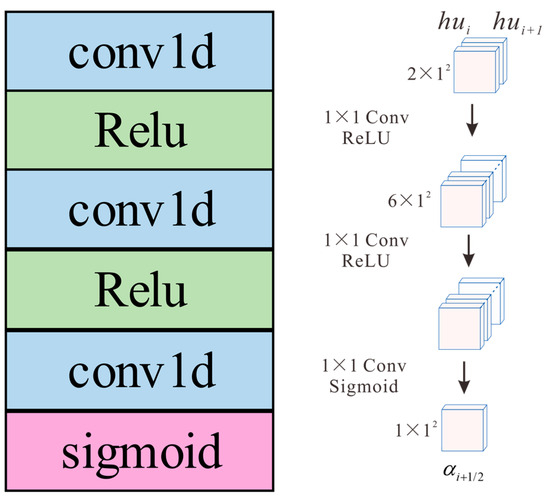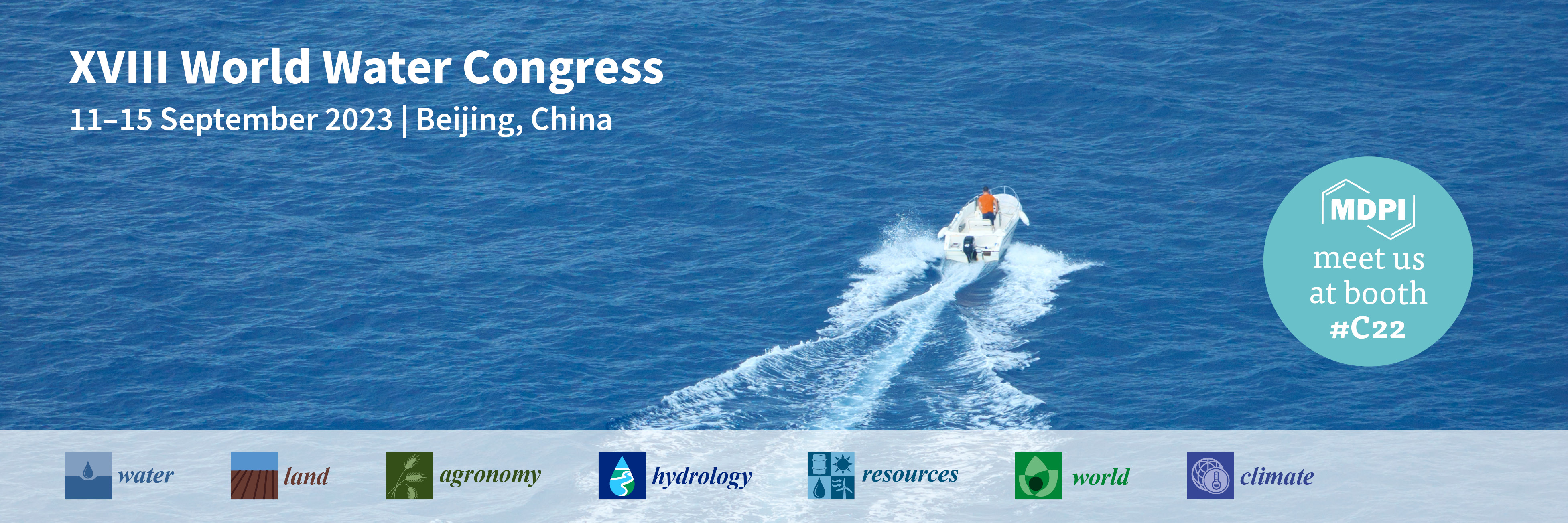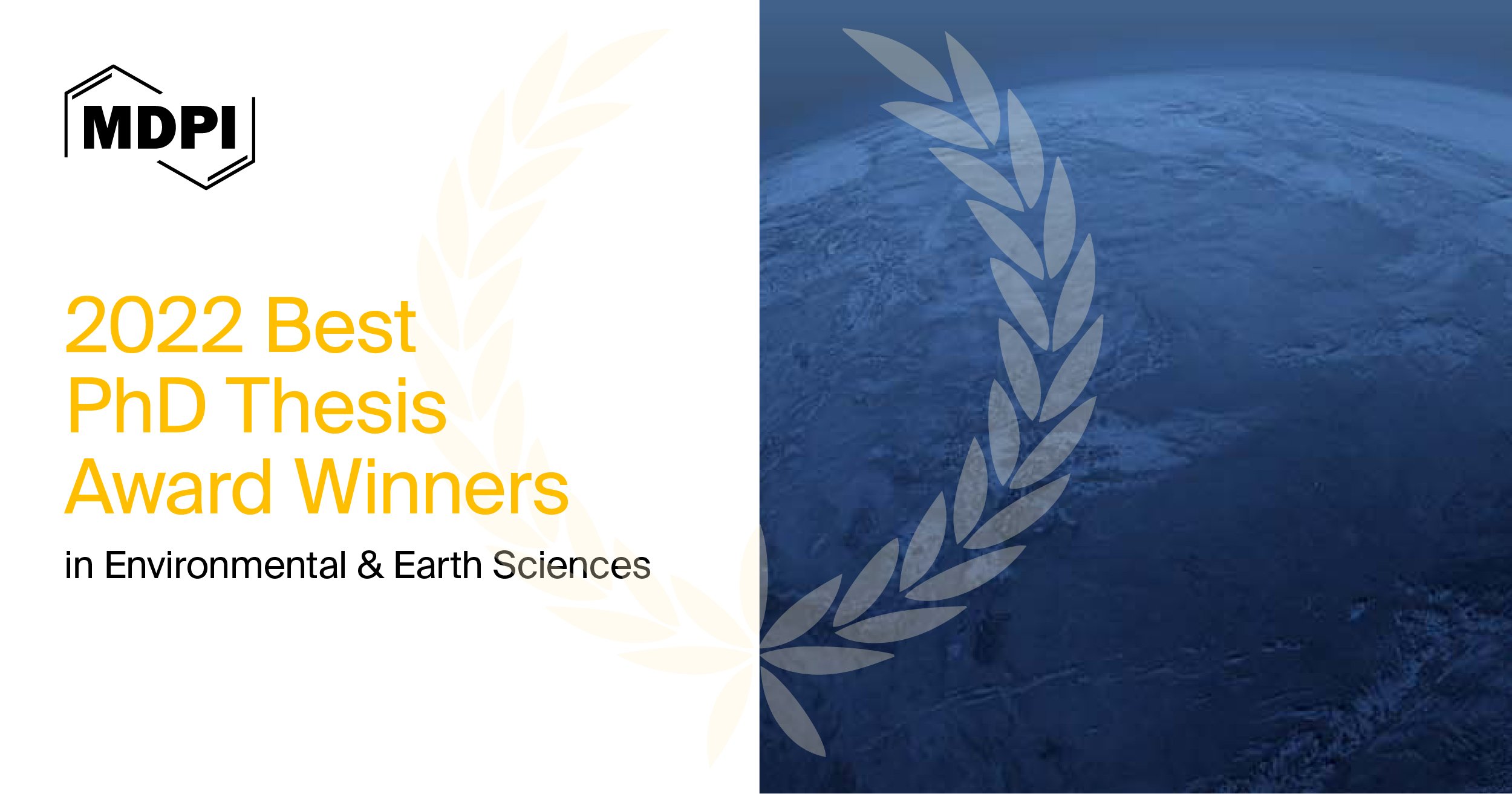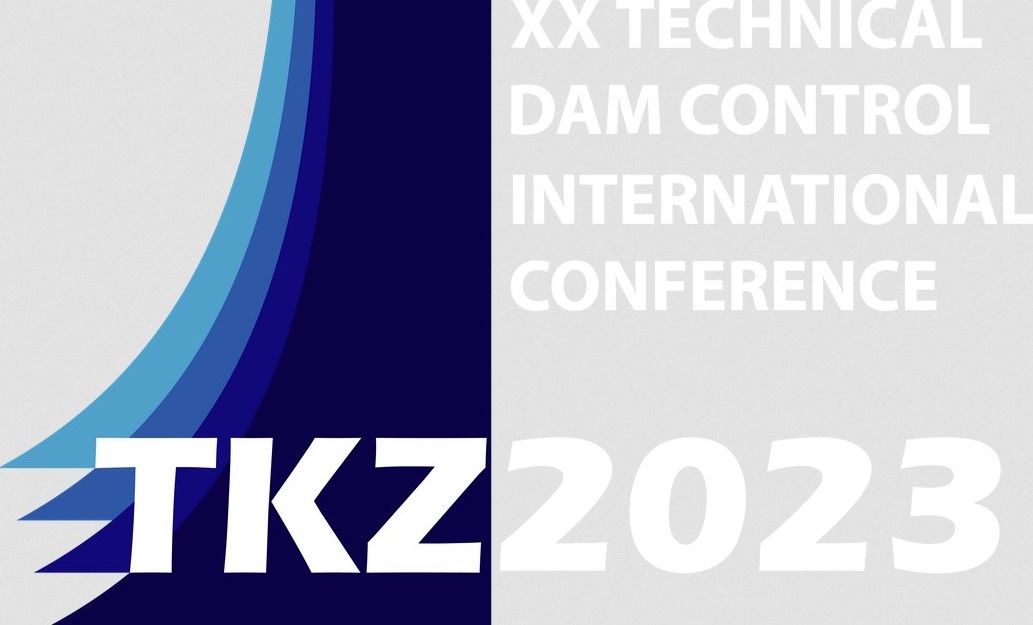Journal Description
Water
Water
is a peer-reviewed, open access journal on water science and technology, including the ecology and management of water resources, and is published semimonthly online by MDPI. Water collaborates with the International Conference on Flood Management (ICFM) and Stockholm International Water Institute (SIWI). In addition, the American Institute of Hydrology (AIH), The Polish Limnological Society (PLS) and Japanese Society of Physical Hydrology (JSPH) are affiliated with Water and their members receive a discount on the article processing charges.
- Open Access— free for readers, with article processing charges (APC) paid by authors or their institutions.
- High Visibility: indexed within Scopus, SCIE (Web of Science), Ei Compendex, GEOBASE, GeoRef, PubAg, AGRIS, CAPlus / SciFinder, Inspec, and other databases.
- Journal Rank: JCR - Q2 (Water Resources) / CiteScore - Q1 (Water Science and Technology)
- Rapid Publication: manuscripts are peer-reviewed and a first decision is provided to authors approximately 16.6 days after submission; acceptance to publication is undertaken in 2.9 days (median values for papers published in this journal in the first half of 2023).
- Recognition of Reviewers: reviewers who provide timely, thorough peer-review reports receive vouchers entitling them to a discount on the APC of their next publication in any MDPI journal, in appreciation of the work done.
- Companion journals for Water include: GeoHazards and Hydrobiology.
Impact Factor:
3.4 (2022);
5-Year Impact Factor:
3.5 (2022)
Latest Articles
A Hybrid Theory-Driven and Data-Driven Modeling Method for Solving the Shallow Water Equations
Water 2023, 15(17), 3140; https://doi.org/10.3390/w15173140 (registering DOI) - 01 Sep 2023
Abstract
In recent years, mountainous areas in China have faced frequent geological hazards, including landslides, debris flows, and collapses. Effective simulation of these events requires a solver for shallow water equations (SWEs). Traditional numerical methods, such as finite difference and finite volume, face challenges
[...] Read more.
In recent years, mountainous areas in China have faced frequent geological hazards, including landslides, debris flows, and collapses. Effective simulation of these events requires a solver for shallow water equations (SWEs). Traditional numerical methods, such as finite difference and finite volume, face challenges in discretizing convection flux terms, while theory-based models need to account for various factors such as shock wave capturing and wave propagation direction, demanding a high-level understanding of the underlying physics. Previous deep learning (DL)-based SWE solvers primarily focused on constructing direct input–output mappings, leading to weak generalization properties when terrain data or stress constitutive relations change. To overcome these limitations, this study introduces a novel SWE solver that combines theory and data-driven methodologies. The core idea is to use artificial neural networks to compute convection flux terms, and to reduce modeling complexity. Theory-based modeling is used to tackle complex terrain and friction terms for the purpose of ensuring generalization. Our method surpasses challenges faced by previous DL-based solvers in capturing terrain and stress variations. We validated our solver’s capabilities by comparing simulation results with analytical solutions, real-world disaster cases, and the widely used Massflow software-generated simulations. This comprehensive comparison confirms our solver’s ability to accurately simulate hazard scenarios and showcases strong generalization on varying terrain and land surface friction. Our proposed method effectively addresses DL-based solver limitations while simplifying the complexities of theory-driven numerical methods, offering a promising approach for hazard dynamics simulation.
Full article
(This article belongs to the Special Issue Advances in Flood and Drought Disaster Forecasting and Early Warnings through Integrating Hydrological and Hydrodynamic Models)
►
Show Figures
Open AccessArticle
A Simplified Method for Effective Calculation of 3D Slope Reliability
Water 2023, 15(17), 3139; https://doi.org/10.3390/w15173139 (registering DOI) - 01 Sep 2023
Abstract
Traditional 3D slope reliability analysis methods have high computational costs and are difficult to popularize in engineering practice. Under the framework of the limit equilibrium method with 3D slip surface normal stress correction, the critical horizontal acceleration coefficient
Traditional 3D slope reliability analysis methods have high computational costs and are difficult to popularize in engineering practice. Under the framework of the limit equilibrium method with 3D slip surface normal stress correction, the critical horizontal acceleration coefficient
(This article belongs to the Special Issue Risk Management Technologies for Deep Excavations in Water-Rich Area)
►▼
Show Figures

Figure 1
Open AccessArticle
Heavy Metal Distribution Characteristics, Water Quality Evaluation, and Health Risk Evaluation of Surface Water in Abandoned Multi-Year Pyrite Mine Area
Water 2023, 15(17), 3138; https://doi.org/10.3390/w15173138 (registering DOI) - 01 Sep 2023
Abstract
►▼
Show Figures
Acid mine drainage (AMD) is a major anthropogenic source of heavy metal discharge worldwide. However, little research has been carried out on the development of AMD in abandoned pyrite mines and the heavy metal contamination of mine surface water. The aim of this
[...] Read more.
Acid mine drainage (AMD) is a major anthropogenic source of heavy metal discharge worldwide. However, little research has been carried out on the development of AMD in abandoned pyrite mines and the heavy metal contamination of mine surface water. The aim of this study was to investigate and assess heavy metal pollution in three streams within an abandoned pyrite mine area in southeastern Shaanxi Province, China. Surface water pollution was assessed using the pollution index assessment method and the health risk assessment model. The results showed that the combined heavy metal pollution indices of the surveyed rivers were Tielu Creek (4699.227), Jiancao Creek (228.840), and Daoban Creek (68.106). After multivariate statistical analysis, it was found that the tailings slag and mine chamber in the abandoned mine area were the main causes of AMD, and AMD posed a serious risk of heavy metal pollution to the surrounding waters. The risk of carcinogenicity of heavy metals is also quite high in the surface water of mining area. Therefore, there is an urgent need to ecologically manage heavy metal pollution from abandoned mine sites, and this study provides insights into understanding heavy metal pollution in the aquatic environment of abandoned mine sites.
Full article
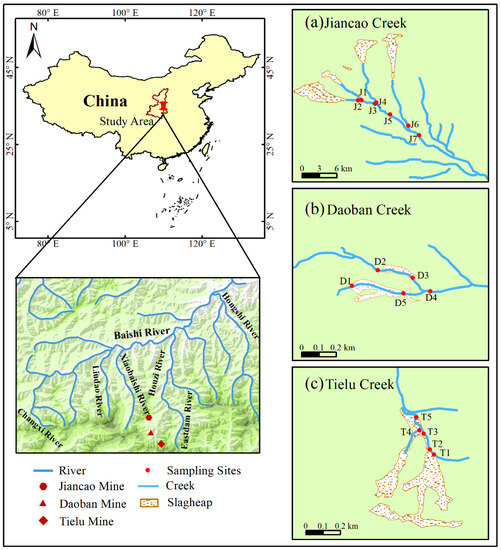
Figure 1
Open AccessArticle
Evaluation of Regional Water Ecological Economic System Sustainability Based on Emergy Water Ecological Footprint Theory—Taking the Yellow River Basin as an Example
Water 2023, 15(17), 3137; https://doi.org/10.3390/w15173137 (registering DOI) - 31 Aug 2023
Abstract
In the article, on the basis of quantifying the emergy water ecological footprint, a sustainability evaluation system for the overall water ecological economic system of the basin and each province (region) was proposed. And using the subjective and objective combination of the Analytic
[...] Read more.
In the article, on the basis of quantifying the emergy water ecological footprint, a sustainability evaluation system for the overall water ecological economic system of the basin and each province (region) was proposed. And using the subjective and objective combination of the Analytic Hierarchy Process (AHP) and Entropy Weight Method (EWM) to determine the weight of the indicator system, a TOPSIS model for sustainability evaluation was constructed. And taking the Yellow River Basin as an example, the results indicate that (1) Throughout the entire basin, the sustainability of the water ecological economic system showed a fluctuating upward trend year by year during the study period, from 0.37 to 0.51. (2) In each province (region), the sustainability of the water ecological economic system had gathered in space. The overall sustainability level of the upstream Sichuan, Qinghai and Gansu provinces is high, always at level (I). The overall sustainability level of the midstream Ningxia and Neimenggu was low, always at level (IV). The overall sustainability level of the downstream Shaanxi, Shanxi, Henan and Shandong provinces is high, rising gradually over time, from level (III) to level (II) or (I). Against the backdrop of the rapid development of the economy and society, the contradiction between economic and social development, ecological environment protection, and sustainable utilization of water resources is becoming increasingly severe, which has become a key factor restricting the sustainable development of the ecological economic system in Yellow River Basin. Multidimensional comprehensive evaluation of the sustainability level of the regional water ecological economic system is a prerequisite for identifying sustainable development issues in the Yellow River Basin, and also the basis for formulating targeted policies for sustainable utilization of regional water resources and high-quality economic development.
Full article
(This article belongs to the Special Issue Yellow River Basin Management under Pressure: Present State, Restoration and Protection II)
Open AccessArticle
Joint Optimal Dispatch of Complex Urban Raw Water Supply: A Case Study of Lanxi City, Zhejiang Province, China
Water 2023, 15(17), 3136; https://doi.org/10.3390/w15173136 (registering DOI) - 31 Aug 2023
Abstract
Water resources play a vital role in supporting urban economic and social development and ecological and environmental protection. Water shortage is a key factor that restricts the high-quality development of cities, while the coordinated and optimized allocation of urban raw water is an
[...] Read more.
Water resources play a vital role in supporting urban economic and social development and ecological and environmental protection. Water shortage is a key factor that restricts the high-quality development of cities, while the coordinated and optimized allocation of urban raw water is an important measure to alleviate the water supply–demand imbalance. The current research on urban water supply issues and their underlying causes still needs to be further strengthened. Similarly, the formulation of rules for multi-source and cross-district water supply should pay more attention. This paper proposes a general analytical process consisting of four main stages: problem identification, system generalization, rule formulation, and model construction and solution for the joint optimal scheduling of raw water in a complex urban water supply system. This study investigates the significant water resource wastage and structural water shortage in the reservoirs of Lanxi City. The optimal scheduling plan is proposed by formulating rational rules for inter-district water supply and establishing a multi-source and multi-objective joint optimization scheduling model. Compared to the current independent scheduling scheme and multi-water source joint dispatching scheme based on the current dispatch diagram, the optimal scheduling plan effectively reduced the cumulative water shortage by 68.04 million m3 and 29.72 million m3, respectively, and increased the urban water supply guarantee rate in all districts of the city to over 90%. This study offers valuable insights to urban water resource managers, empowering them to develop optimal multiple water source supply rules that align to the specific characteristics of other case studies.
Full article
(This article belongs to the Special Issue Water Engineering Safety and Management)
►▼
Show Figures
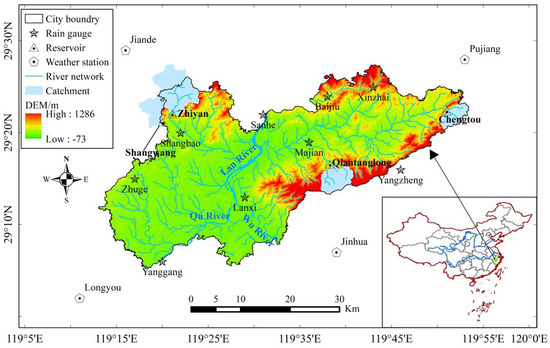
Figure 1
Open AccessArticle
Improvements and Evaluation of the FLake Model in Dagze Co, Central Tibetan Plateau
by
, , , , , , and
Water 2023, 15(17), 3135; https://doi.org/10.3390/w15173135 (registering DOI) - 31 Aug 2023
Abstract
FLake has been one of the most extensively used lake models in many studies for lake thermal structure simulations. However, due to the scarcity of lake temperature observations, its applicability and performance on lakes over the Tibetan Plateau are still poorly investigated, especially
[...] Read more.
FLake has been one of the most extensively used lake models in many studies for lake thermal structure simulations. However, due to the scarcity of lake temperature observations, its applicability and performance on lakes over the Tibetan Plateau are still poorly investigated, especially in small- to medium-sized lakes. In this study, based on water profile observations in Dagze Co, a medium-sized lake on the central Tibetan Plateau, the sensitivity of lake thermal features to three key parameters in FLake was investigated. The performance of FLake in reproducing the lake thermal features was evaluated and improved by optimizing these key parameters. The results showed that the FLake model with default parameter settings can generally reproduce the thermal features of Dagze Co, but there are still significant deviations compared to observation. The sensitive experiments demonstrated that the thermal structure of the lake obviously responds to the change in the water extinction coefficient (Kd), friction velocity (u*), and ice albedo (
(This article belongs to the Special Issue Lake Processes and Lake’s Climate Effects under Global Warming)
►▼
Show Figures
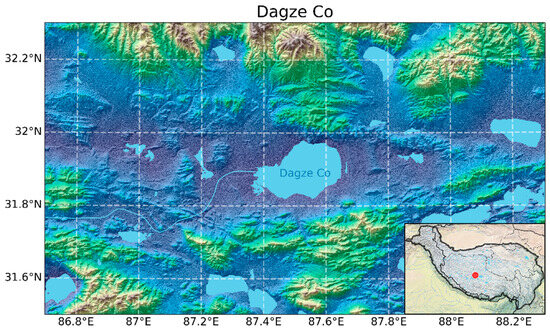
Figure 1
Open AccessArticle
Groundwater Vulnerability to Nitrate Contamination from Fertilizers Using Modified DRASTIC Frameworks
Water 2023, 15(17), 3134; https://doi.org/10.3390/w15173134 (registering DOI) - 31 Aug 2023
Abstract
Vulnerability maps of groundwater provide an efficient means of identifying environmental trends and prioritizing regions for prevention plans. The GIS-based DRASTIC method, however, does not consider the impact of contamination, so there is a need to modify it according to the specifics of
[...] Read more.
Vulnerability maps of groundwater provide an efficient means of identifying environmental trends and prioritizing regions for prevention plans. The GIS-based DRASTIC method, however, does not consider the impact of contamination, so there is a need to modify it according to the specifics of the region and its contamination load. The aim of this study is to investigate a suitable DRASTIC modification for vulnerability assessment by changes in its rating and weighting systems. The goal is to explore and compare the impact of both objective and subjective weighting methods in the vulnerability assessment of a smaller aquifer situated beneath agricultural land. The frequency ratio (FR) method is used to adjust the DRASTIC index rates based on nitrate contamination as the main contamination from fertilizers extensively used in the study area. The DRASTIC parameters’ weights are determined using two objective and subjective methods, including Shannon entropy and single-parameter sensitivity analysis (SPSA), respectively. In total, five frameworks, including FR-DRASTIC, DRASTIC-Entropy, DRASTIC-SPSA, FR-SPSA, and FR-Entropy are developed and evaluated. We validate these proposed vulnerability indices based on the nitrate concentrations in 14 samples. The results show that the vulnerability map obtained from the FR-Entropy framework is superior, showing a 0.85 correlation with nitrate concentrations. Notably, Shannon entropy as an objective weighting method outperformed the subjective SPSA approach.
Full article
(This article belongs to the Special Issue Advances in Aquifer Systems Analysis: Flows, Interactions, Quality Status, and Remediation)
►▼
Show Figures

Figure 1
Open AccessFeature PaperArticle
Glass Eel Restocking Experiments in Typologically Different Upland Rivers: How Much Have We Learned about the Importance of Recipient Habitats?
by
, , , , , , , , , , , and
Water 2023, 15(17), 3133; https://doi.org/10.3390/w15173133 (registering DOI) - 31 Aug 2023
Abstract
The efficiency of glass eel restocking as a conservation measure to restore the altered local eel stocks has never been evaluated by integrating the dimension of typological diversity of freshwater habitats in eel recruitment performance in terms of the abundance, density, growth, silvering,
[...] Read more.
The efficiency of glass eel restocking as a conservation measure to restore the altered local eel stocks has never been evaluated by integrating the dimension of typological diversity of freshwater habitats in eel recruitment performance in terms of the abundance, density, growth, silvering, survival, catchability and eel yields. Here, we used the electrofishing method during a 6-year study to catch eels, and the most appropriate Jolly–Seber model was applied to estimate the demographic parameters in open populations. We found that most eels were yellow eels in the growth phase with a low abundance (eels 3+: 2.8% and eels 5+: 7.1%) of silver eels, which were only males at the MII migrating phase. Eel recruitment performance varied between sector/river habitats. Restocked eels showed annually positive allometric growth type with good length increments and better condition factors. They have survived in almost all sectors with a survival rate > 0.810. Eels were more abundant and denser (maximum 0.128 individuals m−2) in one sector with a high quality of habitats offering optimal living conditions in terms of the protection against predators and water flow, settlement and food availability, as revealed by it having the highest eel yields. In contrast, no eels were found in two sectors whose habitats offered a high threat of predation, poor burial properties and insufficient protection against water flow. Sector/river habitats play a key role in the success of yellow eel production and certainly, over time, future genitor production. This study provides recommendations for the management of eels and their habitats during restocking aimed at the conservation of this threatened species.
Full article
(This article belongs to the Special Issue Freshwater Biodiversity: Conservation and Management)
►▼
Show Figures
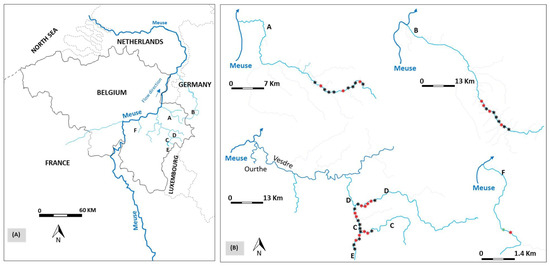
Figure 1
Open AccessArticle
Characteristics and Changes in Water Quality Based on Climate and Hydrology Effects in the Cirata Reservoir
Water 2023, 15(17), 3132; https://doi.org/10.3390/w15173132 - 31 Aug 2023
Abstract
This research aimed to identify water quality changes in the Cirata Reservoir and the factors affecting them in terms of hydrology and climate. The sampling was carried out in both the rainy and dry seasons at 12 locations in the Cirata Reservoir. The
[...] Read more.
This research aimed to identify water quality changes in the Cirata Reservoir and the factors affecting them in terms of hydrology and climate. The sampling was carried out in both the rainy and dry seasons at 12 locations in the Cirata Reservoir. The Mann–Whitney U-test (different test) results showed that salinity, total suspended solids (TSS), the potential of hydrogen (pH), nitrate (NO3-N), phosphate (PO4), nitrate and phosphate content in the sediment were significantly different (α < 0.05) between the rainy and dry seasons. The principal component analysis (PCA) results showed that the water quality characteristics in the Cirata Reservoir in the dry season were influenced by environmental conditions in the reservoir, especially by the floating cage aquaculture and climate conditions. The high solar radiation, low rainfall, and floating cage aquaculture increased the pH and amounts of dissolved oxygen (DO), ammonia (NH3-N), PO4, nitrate and phosphate in the sediment while decreasing transparency, salinity, TSS, and NH3-N. During the rainy season, the high runoff from Citarum Watershed controlled the water quality characteristics of the Cirata Reservoir. In this season, transparency, salinity, pH, DO, NH3-N, PO4, nitrate and phosphate in the sediment increased, while TSS tended to be low. In general, the water volume addition decreased the nutrition and salinity concentration in the water body. However, a distinct phenomenon occurred in the Cirata Reservoir. The runoff from agriculture, settlement, livestock, and the Citatah Karst in the Upper Citarum Watershed increased nutrition and salinity in the reservoir. Land use in the Citarum Watershed and floating cage aquaculture had an important role in the reservoir water quality.
Full article
(This article belongs to the Special Issue Contaminants in the Water Environment)
►▼
Show Figures

Figure 1
Open AccessArticle
Exploring the Sensitivity Range of Underlying Surface Factors for Waterlogging Control
Water 2023, 15(17), 3131; https://doi.org/10.3390/w15173131 - 31 Aug 2023
Abstract
To mitigate the incidence of waterlogging to livelihoods and property security, a combination of management measures has been necessary to achieve optimal benefits, reducing the risk caused by waterlogging to the development of the urban ecology. Thus, this study aims to analyze the
[...] Read more.
To mitigate the incidence of waterlogging to livelihoods and property security, a combination of management measures has been necessary to achieve optimal benefits, reducing the risk caused by waterlogging to the development of the urban ecology. Thus, this study aims to analyze the sensitivity and sensitivity range of management measures under different rainfall conditions, focusing on establishing a foundation for their combined implementation. Based on different rainfall scenarios, the modified Morris method is employed to assess the sensitivity of key factors and subsequently determine their respective sensitivity ranges. The findings reveal that the sensitivity rankings for total overflow volume and maximum pipe flow are as follows: pipe volume per hectare (PV-H), proportion of impervious area (P-Imperv), and slope. Additionally, analyzing the variation pattern of sensitivity with factors highlight the high sensitivity ranges. As for total overflow volume, a very high sensitivity is observed when the P-Imperv ranges from 36.8% to 82.7% (Niujiaolong community) and from 82.7% to 94.5% (Zhuyuan community). Similarly, when PV-H is less than 148 (Niujiaolong community) and 89.6 (Zhuyuan community), the sensitivity of PV-H to total overflow volume is very high. Nevertheless, the slope had a lower influence on the sensitivity in the study areas. These findings provide a complete analysis of the management measures sensitivity, which can be valuable for creating optimal urban waterlogging management systems.
Full article
(This article belongs to the Special Issue Urban Water Management and Hydrological Process)
►▼
Show Figures
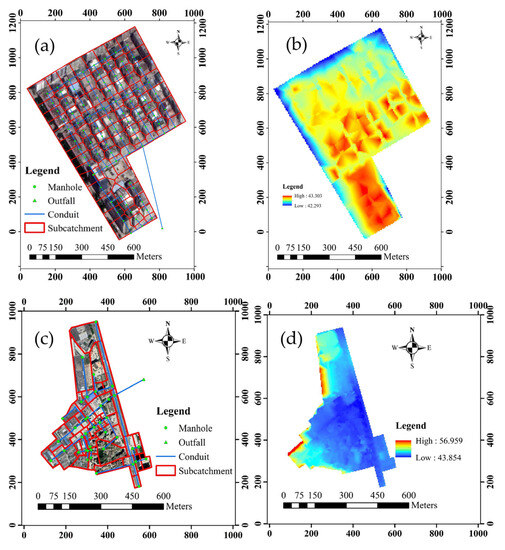
Figure 1
Open AccessReview
Three-Dimensional Numerical Modelling of Real-Field Dam-Break Flows: Review and Recent Advances
Water 2023, 15(17), 3130; https://doi.org/10.3390/w15173130 - 31 Aug 2023
Abstract
Numerical modelling is a valuable and effective tool for predicting the dynamics of the inundation caused by the failure of a dam or dyke, thereby assisting in mapping the areas potentially subject to flooding and evaluating the associated flood hazard. This paper systematically
[...] Read more.
Numerical modelling is a valuable and effective tool for predicting the dynamics of the inundation caused by the failure of a dam or dyke, thereby assisting in mapping the areas potentially subject to flooding and evaluating the associated flood hazard. This paper systematically reviews literature studies adopting three-dimensional hydrodynamic models for the simulation of large-scale dam-break flooding on irregular real-world topography. Governing equations and numerical methods are analysed, as well as recent advances in numerical techniques, modelling accuracy, and computational efficiency. The dam-break case studies used for model validation are highlighted. The advantages and limitations of the three-dimensional dam-break models are compared with those of the commonly used two-dimensional depth-averaged ones. This review mainly aims at informing researchers and modellers interested in numerical modelling of dam-break flow over real-world topography on recent advances and developments in three-dimensional hydrodynamic models so that they can better direct their future research. Practitioners can find in this review an overview of available three-dimensional codes (research, commercial, freeware, and open-source) and indications for choosing the most suitable numerical method for the application of interest.
Full article
(This article belongs to the Special Issue Advances in Dam-Break Modeling for Flood Hazard Mitigation: Theory, Numerical Models, and Applications in Hydraulic Engineering)
►▼
Show Figures
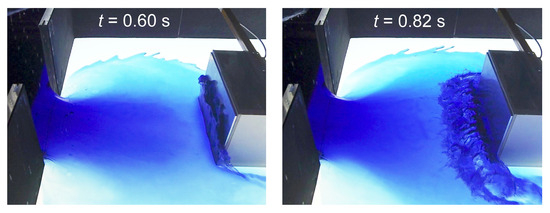
Figure 1
Open AccessArticle
Impact Assessment of the Implementation Effect of the Post-Relocation Support Policies of Rural Reservoir Resettlers’ Livelihoods in Energy Transition
Water 2023, 15(17), 3129; https://doi.org/10.3390/w15173129 - 31 Aug 2023
Abstract
►▼
Show Figures
Energy transition is a major structural change in the whole social system, and the energy system must be changed globally to replace fossil fuels. Hydropower is one of the largest sources of renewable energy in the world. However, owing to the construction of
[...] Read more.
Energy transition is a major structural change in the whole social system, and the energy system must be changed globally to replace fossil fuels. Hydropower is one of the largest sources of renewable energy in the world. However, owing to the construction of hydropower projects, involuntary resettlers are suffering from being far away from their native land, losing the land cultivated for generations and the houses they live in, and losing the social relationship network based on geography and blood ties. Based on the system evaluation theory of reservoir resettlement and referring to relevant research findings, this paper constructs a comprehensive evaluation index framework for assessing the implementation effect of the Post-Relocation Support (PReS) policy. The research region is located in Zhijin County, Bijie City, Guizhou Province, China. Accordingly, a combined method of a structural equation model and a fuzzy comprehensive evaluation model is used in this paper to analyze the implementation of the PReS policy. The results show that the total score of implementing effects of the PReS policy is 4.4, with dramatic significance. The subindex scores of the resettlers’ family income, living conditions, and production conditions; the local economy; and social stability are 4.3, 4.6, 4.4, 4.6, and 4.3, respectively, with dramatic significance. This paper has analyzed and summarized the successful practices of implementing the PReS policy for reservoir resettlers in three dimensions: poverty alleviation, beautiful home construction, and accelerating rural revitalization. Research shows that China’s rural reservoir resettlers’ PReS policy has been more effective in restoring the livelihoods of reservoir resettlers.
Full article
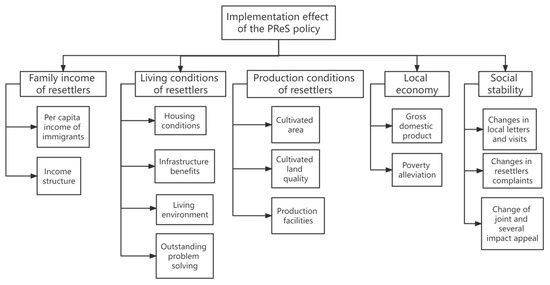
Figure 1
Open AccessArticle
A Special Ordered Set of Type 2 Modeling for a Monthly Hydropower Scheduling of Cascaded Reservoirs with Spillage Controllable
Water 2023, 15(17), 3128; https://doi.org/10.3390/w15173128 - 31 Aug 2023
Abstract
►▼
Show Figures
This study introduces a novel approach for optimizing the monthly hydropower scheduling of cascaded reservoirs by employing a special ordered set of type 2 (SOS2) formulation within a mixed integer linear programming (MILP) model. The proposed method linearizes the relationships between hydropower output,
[...] Read more.
This study introduces a novel approach for optimizing the monthly hydropower scheduling of cascaded reservoirs by employing a special ordered set of type 2 (SOS2) formulation within a mixed integer linear programming (MILP) model. The proposed method linearizes the relationships between hydropower output, spillage, storage, and outflow, enabling controllable spillage. The objective is to minimize spillage, maximize firm hydropower output, and maximize energy production, all in priority while considering complex constraints such as reservoir storage and discharge bounds, upstream–downstream relationship, and water balance. The approach is applied to four cascaded reservoirs on the Lancang River. Results indicate that the SOS2 formulation effectively minimizes spillage, maximizes hydropower generation, and ensures maximum firm power output. Comparisons across different gridding resolutions reveal that more grid points yield greater benefits but with a longer solution time. Furthermore, a comparison with the Successive Quadratic Programming (SQP) method highlights the superior performance of the SOS2 model in terms of objective improvement and solution efficiency. This research offers valuable insights into optimizing monthly hydropower scheduling for cascaded reservoir systems, enhancing operational efficiency and decision-making in water resources management.
Full article
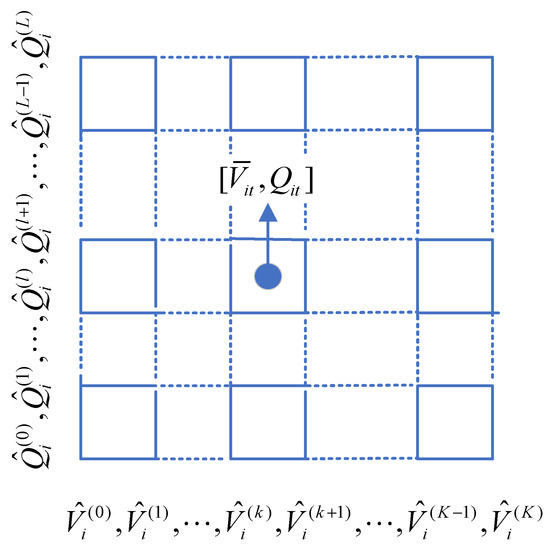
Figure 1
Open AccessArticle
Characteristics of Hydrogen–Oxygen Isotopes and Water Vapor Sources of Different Waters in the Ili Kashi River Basin
Water 2023, 15(17), 3127; https://doi.org/10.3390/w15173127 - 31 Aug 2023
Abstract
►▼
Show Figures
The Ili Kashi River Basin is an area with relatively abundant precipitation within the arid region of Northwest China. Using water samples from atmospheric precipitation, surface water, groundwater, and snow meltwater in the basin from July 2018 to June 2021, the isotope characteristics
[...] Read more.
The Ili Kashi River Basin is an area with relatively abundant precipitation within the arid region of Northwest China. Using water samples from atmospheric precipitation, surface water, groundwater, and snow meltwater in the basin from July 2018 to June 2021, the isotope characteristics of the different water bodies in the study area were determined from the perspectives of altitude, season, and interannual changes. Combined with the meteorological data on precipitation and the HYSPLIT model, the water vapor sources of atmospheric precipitation in the Ili Kashi River Basin were tracked and analyzed. Studying the hydrogen and oxygen stable isotopes in the different water bodies in this area can provide substantial scientific support for the generation, development, and change processes of river water resources in Northwest China, and has practical significance for the utilization of water resources. The results derived are as follows. (1) Hydrogen–oxygen isotope changes in the Ili Kashi River Basin were broadly characterized by a continuous enrichment from low-to-high elevations in the summer to a maximum value, followed by gradual depletion, whereas the changes in δ18O and δD were reversed in autumn. (2) The river water values of δD and δ18O fluctuated between −107.15‰ and −68.13‰ and between −18.53‰ and −9.66‰, respectively, during the study period. (3) The variation in δ18O and δD in the precipitation was consistent, showing characteristics of summer enrichment and winter dilution, and the precipitation line equation is δD = 7.30δ18O + 9.29. (4) In autumn and winter, the groundwater δD and δ18O values fluctuated between −99.87‰ and −84.95‰ and between −15.50‰ and −10.38‰, respectively; during spring and summer, the δD and δ18O values varied from −99.27‰ to −87.07‰ and from −15.15‰ to −12.00‰, respectively. The hydrogen–oxygen stable isotope value of the ice–snow meltwater in autumn was higher than that in summer. (5) On the basis of the d-excess variation in each precipitation event over the 3 years and an analysis of the water vapor sources using the HPSPLIT backward trajectory tracking model, the source of water vapor in the study area is primarily the surrounding land water vapor, with the Atlantic Ocean being the main contributor of oceanic water vapor.
Full article

Figure 1
Open AccessArticle
Spatiotemporal Patterns of Heavy-Metal Pollution in Coastal Pinqing Lagoon (Southern China): Anthropogenic and Hydrological Effect
Water 2023, 15(17), 3126; https://doi.org/10.3390/w15173126 - 31 Aug 2023
Abstract
Coastal lagoons connecting the land and sea provide essential ecosystem services. However, emerging environmental issues such as environmental pollution and ecological degradation from rapid socio-economic development in coastal zones of south China are becoming increasingly prevalent. This study examined the spatiotemporal variation, sources,
[...] Read more.
Coastal lagoons connecting the land and sea provide essential ecosystem services. However, emerging environmental issues such as environmental pollution and ecological degradation from rapid socio-economic development in coastal zones of south China are becoming increasingly prevalent. This study examined the spatiotemporal variation, sources, assessments, and driving forces of heavy metals based on core and surface sediments collected from Pinqing Lagoon, a coastal lagoon in South China. Sediment cores (PQ1, PQ2, and PQ3) showed distinct vertical variations in the content of Cu, Cd, Zn, Pb, As, and Sb with an average coefficient of variation (C.V.) of 0.25. However, a relatively lower vertical variation (C.V. mean = 0.13) was shown by the other elements (Mn, V, Ni, Cr, and Co). Although Cu was the chief pollutant heavy metal and it had mean values of 1.6 and 1.7 for the enrichment factor (EF) and contamination factor (CF), respectively, Cd posed the highest ecological risk (
(This article belongs to the Section Oceans and Coastal Zones)
►▼
Show Figures
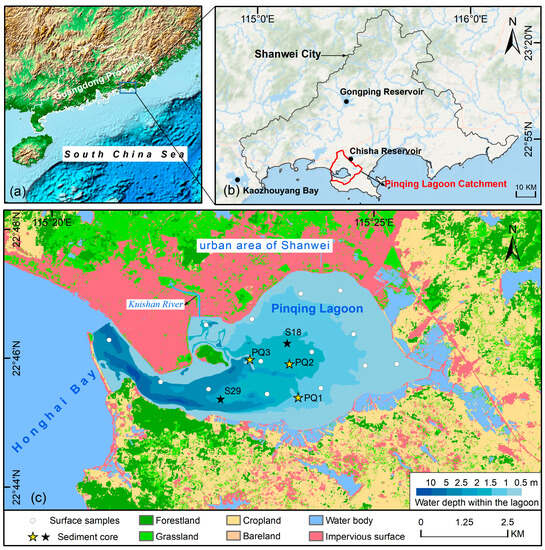
Figure 1
Open AccessFeature PaperArticle
Research on Performance Test of the Optic-Electric Sensors for Reservoir Landslide Temperature Field Monitoring
by
, , , , , , and
Water 2023, 15(17), 3125; https://doi.org/10.3390/w15173125 - 31 Aug 2023
Abstract
In recent years, with the superposition of extreme climate, earthquakes, engineering disturbance and other effects, global landslide disasters occur frequently. Due to reservoir landslides being mostly in a multi-field coupling environment, the temperature field will impact the deformation and seepage fields, thereby affecting
[...] Read more.
In recent years, with the superposition of extreme climate, earthquakes, engineering disturbance and other effects, global landslide disasters occur frequently. Due to reservoir landslides being mostly in a multi-field coupling environment, the temperature field will impact the deformation and seepage fields, thereby affecting the stability of the reservoir landslide. The variation in the landslide’s surface temperature also directly affects the stress and deformation of deep rock masses. If hidden dangers are not detected in time, and corresponding measures are implemented, it is easy to cause landslide instability. In order to clarify the temperature measurement performance of different optic-electric sensors and the application characteristics of layout techniques, laboratory calibration tests of temperature sensors under different adhesives and attachment materials are carried out in this paper. It was found that the test data of the iron bar had the best effect among the four attachment materials overall. Therefore, the bar with a high-stiffness material should be preferred when selecting a pipe fitting as the fiber Bragg grating (FBG) temperature attachment in the borehole. However, considering the high requirements for the durability of sensors and layout techniques in on-site monitoring, the long-term stability of the adhesives used in actual monitoring needs to be improved. At the same time, it was found that the platinum 100 (PT100) temperature sensor has relatively higher testing accuracy (A: 0.15 + 0.002 × |t|; B: 0.30 + 0.005 × |t|), a larger temperature measurement range (−200~+850 °C) and better temperature measurement stability when compared to conventional sensors. Moreover, its resistance value has a good linear relationship with temperature. Finally, the Xinpu landslide in the Three Gorges Reservoir area was selected as the research object for on-site monitoring. There was a high correlation between the on-site monitoring results with the laboratory calibration test results. Therefore, through the performance test of optic-electric sensors in reservoir landslide temperature fields, more accurate solutions can be provided for selecting sensors and designing layout techniques to monitor the underground temperature field of landslides under different geological conditions. Thereby, grasping the real-time state information of the reservoir landslide temperature field is achieved accurately, providing an important reference for early warning, prediction, prevention and the control of reservoir landslide disasters.
Full article
(This article belongs to the Special Issue Recent Research on Reservoir Landslide Stability)
►▼
Show Figures
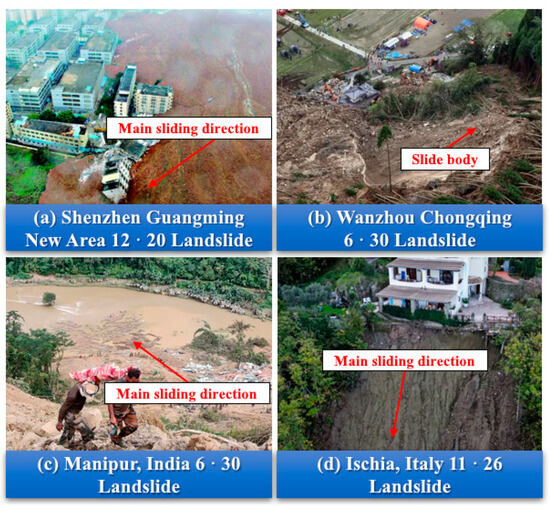
Figure 1
Open AccessArticle
A Bayesian Network-Based Inhibition Model of the Rainstorm–Landslide–Debris Flow Disaster Chain in Mountainous Areas: The Case of the Greater Bay Area, China
Water 2023, 15(17), 3124; https://doi.org/10.3390/w15173124 - 31 Aug 2023
Abstract
►▼
Show Figures
In this study, a Bayesian network (BN)-based inhibition model is developed for the rainstorm–landslide–debris flow (R-L-D) disaster chain in the mountainous area of the Greater Bay Area (GBA), China, using the historical disaster data. Twelve nodes are selected for the inhibition model, which
[...] Read more.
In this study, a Bayesian network (BN)-based inhibition model is developed for the rainstorm–landslide–debris flow (R-L-D) disaster chain in the mountainous area of the Greater Bay Area (GBA), China, using the historical disaster data. Twelve nodes are selected for the inhibition model, which are classified into four types, including Hazardous Factor, Response Operation, Disaster Evolution, and Disaster Result. By combining the proposed inhibition with the scenario analysis method, the probabilities of the BN nodes under different rainfall scenarios are analyzed, and then the inhibitory effects of the environmental geological conditions and rescue speed on the R-L-D disaster chain under the most unfavorable rainfall scenario are investigated. On this basis, an inhibition framework consisting of the early warning, inhibition, and measures layers is proposed for the R-L-D disaster chain. The results reveal that under the most unfavorable rainfall scenarios, where the rainfall intensity is greater than 100 mm/d and the rainfall duration is greater than 24 h, the probability of landslides and debris flow is 0.930 and 0.665, respectively. Improving the environmental geological conditions such as slope, lithology and geological structure can greatly inhibit the occurrence of the R-L-D disaster chain. Moreover, the improvement of geological structure conditions is the most significant, and reduces the probability of landslides and debris flow by 0.684 and 0.430, respectively, as well as reducing the probability of death and direct economic loss by 0.411 and 0.619, respectively. Similarly, increasing the rescue speed leads to a reduction in the probability of death and direct economic loss by 0.201 and 0.355, respectively. This study can provide theoretical and practical insights into the prevention and inhibition of the R-L-D disaster chain.
Full article

Figure 1
Open AccessArticle
Viability of Reclaiming Municipal Wastewater for Potential Microalgae-Based Biofuel Production in the U.S.
Water 2023, 15(17), 3123; https://doi.org/10.3390/w15173123 - 31 Aug 2023
Abstract
Reclaimed municipal wastewater is a crucial component in biofuel production, especially in regions experiencing increasing freshwater scarcity. However, accurately estimating the potential for fuel production is challenging because of the uneven distribution of biofuel feedstock regions and wastewater treatment plants (WWTPs). This study
[...] Read more.
Reclaimed municipal wastewater is a crucial component in biofuel production, especially in regions experiencing increasing freshwater scarcity. However, accurately estimating the potential for fuel production is challenging because of the uneven distribution of biofuel feedstock regions and wastewater treatment plants (WWTPs). This study assesses the viability of using reclaimed municipal water for algal biomass production in pond systems co-located with WWTPs under scenarios driven by biomass production and based on water transport logistics. We performed state- and county-level analysis of reclaimed water resources throughout the United States based on WWTP facility data. We overlaid these data onto estimated algae facility sites and examined the temporal resource availability to address seasonal variations in cultivation demand. Our findings reveal that 2694 billion liters per year of reclaimed water could potentially be used to produce 42.2 million metric tons (ash-free dry weight) of algal biomass, equivalent to 29.2 billion liters of renewable diesel equivalent (RDe). The use of reclaimed water would double current national water reuse and expand such reuse significantly in 455 counties across the United States. However, when we limit the construction of algae facilities to counties that can fully meet their water demand in order to minimize water transport burdens, the available supply decreases by 80%, to 512 billion liters, resulting in annual production of 12.2 billion liters of RDe, which still doubles current biodiesel production. Our analysis highlights the degree to which the location and flow of WWTPs and water transport affect the deployment of algae biofuel facilities and tradeoffs. These findings underscore the importance of improving the current WWTP infrastructure for reclaimed water reuse, especially in southern states.
Full article
(This article belongs to the Special Issue Relationship of Energy and Water Resource Availability)
►▼
Show Figures
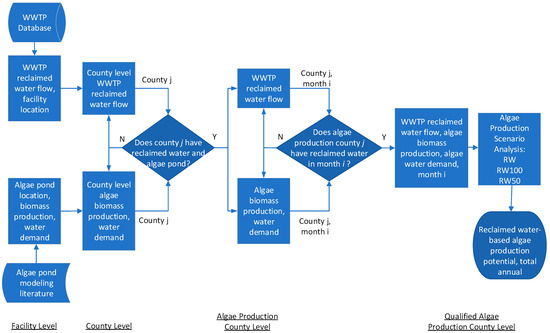
Figure 1
Open AccessArticle
Nitrate Reduction through Al-Fe Alloy Catalyst: Effects of Activation Pre-Treatment Method and Alloy Type
Water 2023, 15(17), 3122; https://doi.org/10.3390/w15173122 - 31 Aug 2023
Abstract
This study explored the nitrate reduction by Al-Fe alloy. The nitrate conversions of fresh, 30-day and 90-day alloys were 78.1%, 42.8% and 9.5%, respectively. Water activation promoted the reducing ability of the alloy (98% nitrate removal), which was higher than that of copper
[...] Read more.
This study explored the nitrate reduction by Al-Fe alloy. The nitrate conversions of fresh, 30-day and 90-day alloys were 78.1%, 42.8% and 9.5%, respectively. Water activation promoted the reducing ability of the alloy (98% nitrate removal), which was higher than that of copper deposited alloy (66%) and H2-reducing/acid/alkali/Cl− activated alloy (no enhancement). The effects of pre-treatments on the surface O fraction changes confirmed the activation results. With increased Fe:Al mass ratio in the alloy, nitrate conversion initially decreased and then increased again, verifying the proposed electron-donator activity of Al or Fe in alloys. Al-Fe30 had the highest NO3− conversion and Al13Fe4 content, so Al-Fe30 was selected. Significant differences in conversion were observed in alloy usages of 5–10 and 15–30 g/L. High reduction performance (nitrate below the detection limit and 19.1% N2 selectivity) was achieved under the optimal conditions: 15 g/L Al-Fe30, 150 min reaction and without pH adjustment. The rate constants of nitrate removal, nitrogen generation and ammonia generation were k1 = 1.43 × 10−2, k2 = 3.41 × 10−2 and k3 = 10.58 × 10−2 min−1, respectively. The value of (k2 + k3)/k1 was 10, indicating that the conversion of nitrate into nitrite was the rate-determining step. The repetition reaction was performed, and the rate constant decreased as the reaction step was repeated.
Full article
(This article belongs to the Special Issue Sustainable Governance for Resilient Water and Sanitation Service)
►▼
Show Figures
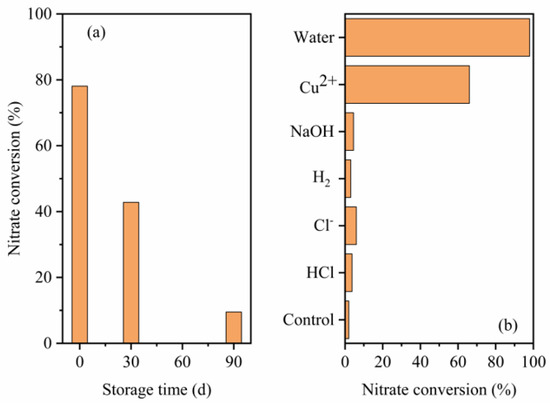
Figure 1
Open AccessArticle
Study on the Analysis of Pile Foundation Deformation and Control Methods during the Excavation of Deep and Thick Sludge Pits
Water 2023, 15(17), 3121; https://doi.org/10.3390/w15173121 - 30 Aug 2023
Abstract
This study aims to apply performance-based safety-assessment methods to the monitoring and numerical simulation of excavation engineering projects in order to comprehensively enhance engineering risk management and decision support. In this paper, a deep excavation project in Hefei with thick silty clay layers
[...] Read more.
This study aims to apply performance-based safety-assessment methods to the monitoring and numerical simulation of excavation engineering projects in order to comprehensively enhance engineering risk management and decision support. In this paper, a deep excavation project in Hefei with thick silty clay layers was studied. The analysis included the surface settlement, the deformation of support structures, the vertical and horizontal displacements of pile tops, axial forces in steel braces, settlement, and the horizontal displacement of a gravity retaining wall on the south side of the excavation using field-monitoring data. A refined three-dimensional finite element model was established to further analyze the distribution of uplift displacement at the bottom of the excavation, horizontal displacement, and bending moments of piles based on simulation results. The research findings indicate that phased excavation can reduce the spatial extent of disturbance to the surrounding soil caused by excavation. Additionally, the closer the location to the excavation and the thicker the underlying silty clay layer, the faster the rate of settlement change and the greater the surface settlement. The spatial structure formed by steel braces and pile foundations effectively reduced the horizontal displacement of the engineering piles. The study’s use of field monitoring and finite element simulation provided valuable insights into the deformation of support structures and the response of the surrounding soil to excavation, confirming the rationality and applicability of the support structure in this paper. The proposed method can serve as a reference for similar complex stratum excavation design and construction. The performance-based safety assessment is introduced, and the monitoring data, numerical simulation results, and performance targets are comprehensively analyzed to provide a reliable scientific basis for engineering decision making.
Full article
(This article belongs to the Special Issue Risk Management Technologies for Deep Excavations in Water-Rich Area)
►▼
Show Figures
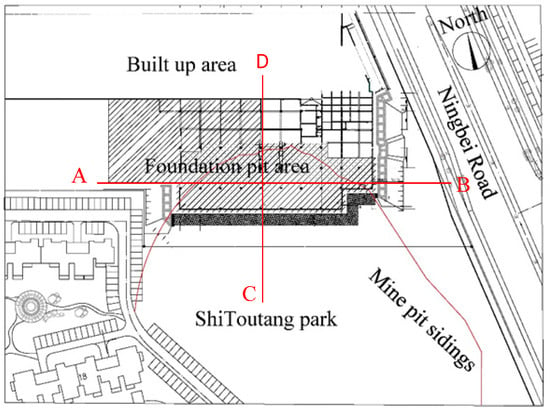
Figure 1

Journal Menu
► ▼ Journal Menu-
- Water Home
- Aims & Scope
- Editorial Board
- Reviewer Board
- Topical Advisory Panel
- Instructions for Authors
- Special Issues
- Topics
- Sections & Collections
- Article Processing Charge
- Indexing & Archiving
- Editor’s Choice Articles
- Most Cited & Viewed
- Journal Statistics
- Journal History
- Journal Awards
- Society Collaborations
- Conferences
- Editorial Office
Journal Browser
► ▼ Journal BrowserHighly Accessed Articles
Latest Books
E-Mail Alert
News
Topics
Topic in
Energies, Geosciences, JMSE, Minerals, Water
Basin Analysis and Modelling
Topic Editors: Jingshou Liu, Wenlong Ding, Ruyue Wang, Lei Gong, Ke Xu, Ang LiDeadline: 20 September 2023
Topic in
Energies, Materials, Processes, Water, J. Compos. Sci.
Advances in Adsorption Desalination and Cooling Systems
Topic Editors: Jaroslaw Krzywanski, Marcin Sosnowski, Karol Sztekler, Anna Pajdak, Anna Zylka, Anna Kulakowska, Karolina Grabowska, Dorian SkrobekDeadline: 30 September 2023
Topic in
Energies, Membranes, Molecules, Separations, Water
Sustainable Water Purification Technologies for Multiple Applications
Topic Editors: Marco Pellegrini, Cesare Saccani, Alessandro GuzziniDeadline: 15 October 2023
Topic in
Geosciences, Hydrology, IJERPH, Remote Sensing, Water
Groundwater Pollution Control and Groundwater Management
Topic Editors: Yunhui Zhang, Qili Hu, Liting HaoDeadline: 31 October 2023

Conferences
28 August–2 September 2023
18th International Conference on Environmental Science and Technology | CEST2023

Special Issues
Special Issue in
Water
Advances in Floodplain Morphodynamics of Lowland Rivers
Guest Editor: Tomasz FalkowskiDeadline: 4 September 2023
Special Issue in
Water
Inland Surface Water and Deep Learning
Guest Editors: Min Feng, Chengquan Huang, Do-Hyung Kim, Wenlong JingDeadline: 10 September 2023
Special Issue in
Water
Advances in Biofiltration Processes for Drinking Water and Wastewater Treatment
Guest Editor: Akintunde O. BabatundeDeadline: 30 September 2023
Special Issue in
Water
The Role of Snow in High-Mountain Hydrologic Cycle
Guest Editor: Hongyi LiDeadline: 15 October 2023
Topical Collections
Topical Collection in
Water
Water Policy Collection
Collection Editors: Meri Raggi, Davide Viaggi, Giacomo Zanni





